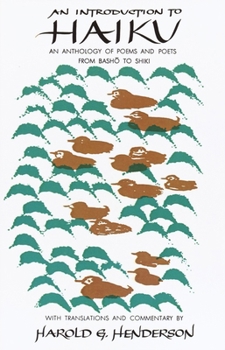Intro to Haiku: An Anthology of Poems and Poets from Basho to Shiki
Select Format
Select Condition 
Book Overview
Harold G. Henderson was, from 1927 to 1929, the Assistant to the Curator of Far Eastern Art at the Metropolitan Musuem of Art. In 1930 he went to Japan, where he lived the following three years. On his return to this country he joined the faculty at Columbia University, where he taught Japanese and initiated a course in the history of Japanese art. He retired in 1955. His published works include The Bamboo Broom , Surviving Works of Sharaku (with...
Format:Paperback
Language:English
ISBN:0385093764
ISBN13:9780385093767
Release Date:October 1958
Publisher:Anchor Books
Length:192 Pages
Weight:0.44 lbs.
Dimensions:0.5" x 5.5" x 8.4"
Customer Reviews
4 ratings
Haiku considered. . . .
Published by Thriftbooks.com User , 16 years ago
Haiku, well done, is an enchanting poetic form. This book, put together by Harold Henderson, provides a nice introduction for those who want a deeper understanding of this art form. Best of all is the array of poems presented here--from Basho, Buson, Issa, Shiki, and others. Haiku itself is deceptively simple--3 lines: 5 syllables in the first, seven in the second, five in the third, for seventeen in total. But it is much more than that. And that is what makes the first part of this book so useful. The Preface and Introduction provide a literate consideration to the nature--and difficulty of drafting--haiku. Even more challenging is translating Japanese haiku into English, according to Anderson (who does the actual translation in this volume). He notes, for instance, an Italian adage, "traduttore, traditore," which--he claims--means that a translator is probably a traitor. To change 17 syllables of Japanese haiku to a meaningful and still poetic English format is devilish difficult. He says (Page vii): "My intention has been to write English verse which will be faithful to the spirit of the originals, and will at the same time approximate literal translation. . . ." Chapters I and II provide a brief but helpful sense of the nature of haiku itself, from its origins to its nature to its evolution. And then the book moves into the poets themselves, selecting four masters of haiku, plus selected other practitioners of the art. In the process the poets are discussed, their individual attributes summarized, and--best of all from my view--selections of their work presented. Since Basho has been my favorite over time, I'll simply present some of the haiku that seem special to me. "On the Road to Nara" Oh, these spring days! A nameless little mountain, Wrapped in morning hazel. "Leaving the House of a Friend" Out comes the bee From deep among the peony pistils-- Oh, so reluctantly! "Twilight" "Hawk-eyes too will fail, Now that the darkness comes"-- So chirp the quail. So, a delightful work providing background to haiku and some wonderful examples of the masters and their craft.
Beautifully done
Published by Thriftbooks.com User , 18 years ago
As Henderson points out in his introduction, most translators are traitors. Though this is so in many cases, the pieces that he selected work well and push the envelope of what good translation of poetry of all kinds should be, regardless of the original language. This is an excellent pocket anthology for any lover of Haiku and other short form poetry to carry with them always.
Masterful Introduction to Haiku
Published by Thriftbooks.com User , 22 years ago
I have rarely encountered better translations of Haiku. Henderson brought the extended meanings of the words across. Double and triple entendres, startling juxtapositions, contextual clues, everything. These are not mere literal translations--they work on multiple levels to extend the meaning of the poetry, to reflect the possible readings by literate Japanese readers.Poetic translation is an art that requires deep understanding of two languages, poetic heritages, and metaphorical/imagistic libraries. Henderson's translations are unique in their quality.
Essential introduction for those interested in haiku
Published by Thriftbooks.com User , 24 years ago
Although Henderson's book is out-of-print (originally published in 1958), and his translations are stylistically out-of-date (i.e., rhymed English haiku), this is an essential, pocket-sized anthology. Henderson intersperses his chronological presentation of haiku, in both transliterized Japanese (romaji) with English translation, by major historical masters with analysis throughout. I am on my second paperback -- the first fell apart from constant use!






